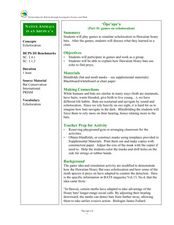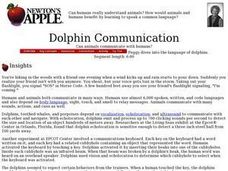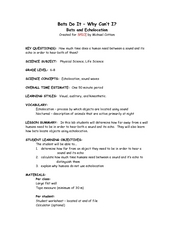Curated OER
Games on Echolocation
Get a little batty with life science! This fun simulation game replicates how bats use echolocation to hunt moths in their native Hawaiian habitat. After creating blind folds and discussing some basic principles of echolocation, students...
Curated OER
Echolocation
Students explore echolocation. In this bats science lesson, students compare sunlight reflecting off a mirror to sound waves hitting a bat's ears. Students complete a worksheet about bats.
Alabama Learning Exchange
Echolocation Stations: Exploring Sound
Fourth graders explore the concept of echolocation during a unit on whales. They listen to the book and watch the Reading Rainbow video for "Humphrey: The Wayward Whale," explore various websites, and conduct experiments to demonstrate...
Curated OER
Echolocation Lab
High schoolers explore echolocation of animals. They examine how dolphins and other echolocating animals use their senses to locate and identify objects without using their sense of sight. Through experimentation, they discover how sound...
Curated OER
Sound for Sight
Students study echolocation and understand how dolphins use it to locate prey, escape predators, and navigate their environment. They view a video, "In the Wild-Dolphins with Robin Williams" and see first hand how dolphins communicate. ...
Curated OER
Let Your Ears Do the Walking
Pupils examine the effects of bycatching on water environments. They discover how echolocation works. They participate in a simulation of the process to use it while walking blindfolded.
Curated OER
Dolphin Communication
Pupils listen to a lecture on dolphin communication methods. They consider ways in which humans communicate and participate in an activity to assess the role of smell in human communication.
Curated OER
Waves
Young scholars identify the different parts of a wave. In this physics lesson, students explain how animals communicate using sound waves. They discuss the effect of Navy's sonar on dolphins and whales.
Curated OER
Bats: Fact and Fiction
Students describe the characteristics and behaviors of bats. After viewing a video, they explain how bats use echolocation to navigate and how they find their young within a group. They list four misconceptions about the animal and...
Curated OER
Placebo - 1
Students explore the placebo effect, thus producing the positive effects of acupuncture without needle insertion. Students discuss echolocation. They participate in hands-on/minds-on activities in reflected sound waves. They...
Curated OER
Can You Hear It?
Students work together to discover the concept of echolocation. They examine dolphins and their behaviors. They discuss how humans could use this information to help them in their everyday lives as well.
Curated OER
Echo Location
Learners participate in a role-playing activity that demonstrates how whales use sound as an adaptation to their environment.
Curated OER
Bats Do It-Why Can't I?
Students explore echos and how they are utilised in navigation. In this sound lesson students calculate the amount of time between a sound and its echo.
Curated OER
Come to Mommy
Fourth graders participate in a simple experiment to illustrate the concept of mother bats identifying their young. They sniff stickers in order to imitate the behavior of mother bats in the wild.
Curated OER
What Shape Is It?
Learners predict the shape of an unknown object by bouncing a ball on it. In this physics instructional activity, students relate this activity to how dolphins use echo-location to navigate. They analyze their lab result and discuss...
Other popular searches
- Echolocation Bats
- Whale Echolocation
- Dolphin Echolocation
- Echolocation Activities
- Ocean Echolocation
- Bats and Echolocation
- Science; Echolocation
- Echolocation Whales
- Long Nosed Bat Echolocation
- Echolocation in Bats
- Science Echolocation
- Bat Echolocation Activities
















